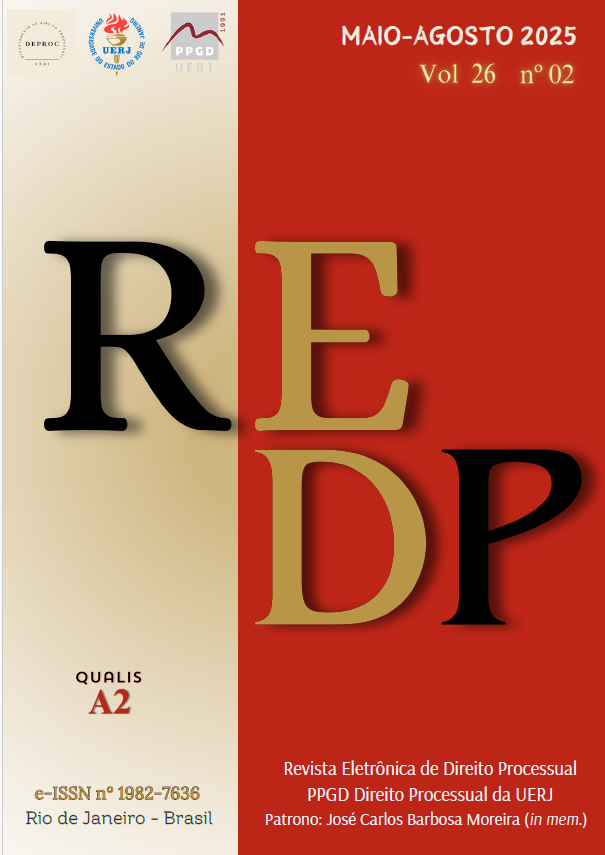Falsas Verdades. O Impacto das Alucinações de IA nos Processos Judiciais Administrativos
DOI:
https://doi.org/10.12957/redp.2025.90706Resumo
A crescente integração da Inteligência Artificial (IA) no sistema jurídico português apresenta desafios significativos, sendo um dos mais preocupantes o fenómeno das "alucinações" de IA. Este problema ocorre quando os sistemas de IA geram informações aparentemente plausíveis, mas factualmente incorretas, podendo comprometer a segurança jurídica e a fiabilidade das decisões judiciais. A utilização destas ferramentas nos tribunais administrativos, levanta questões complexas quanto à sua credibilidade, ética e regulamentação, exigindo uma análise aprofundada dos seus impactos na justiça administrativa.
Com o presente estudo, pretendemos analisar as implicações das alucinações de IA, no âmbito do direito processual administrativo, apresentando casos concretos em que a confiança excessiva nas ferramentas automatizadas culminou em erros graves. A crescente dependência da IA para a análise e interpretação de documentos jurídicos, para a redação de peças processuais e para a prolação das decisões demonstra a necessidade urgente de estabelecer normas rigorosas que garantam a verificação e validação das informações geradas. Analisaremos também, a importância de definir um quadro regulatório adequado para mitigar os riscos associados à IA no sistema judicial. A clareza no papel dos juízes, advogados e demais operadores jurídicos na supervisão da tecnologia assume um papel fundamental, para evitar falhas no julgamento de processos. Torna-se essencial promover a literacia digital entre os profissionais do direito, permitindo-lhes avaliar criticamente os resultados gerados por sistemas de IA .Por fim, apresentam-se recomendações para um uso prudente e regulamentado da IA no ordenamento jurídico português. A implementação de diretrizes rigorosas pode contribuir para um equilíbrio entre inovação e segurança jurídica, garantindo que a adoção destas tecnologias respeite os princípios fundamentais da justiça e do devido processo jurídico.
Downloads
Publicado
Como Citar
Edição
Seção
Licença
Copyright (c) 2025 Bárbara Magalhães, Fátima Matos

Este trabalho está licenciado sob uma licença Creative Commons Attribution 4.0 International License.
Todos os artigos publicados na Revista Eletrônica de Direito Processual (REDP) (Departamento de Direito Processual, Universidade do Estado do Rio de Janeiro, Brasil) são licenciados por meio de uma Licença Creative Commons - Atribuição 4.0 Internacional (CC BY 4.0).
Os autores retêm os direitos autorais de seu artigo e concordam em licenciar seu trabalho com a licença CC BY 4.0, aceitando assim os termos e condições específicos desta licença disponíveis no seguinte website: https://creativecommons.org/licenses/by/4.0/legalcode.
- Os autores concedem à REDP o direito de primeira publicação, de se identificar como publicadora original do trabalho e concedem à revista uma licença de direitos não exclusivos para utilizar o trabalho das seguintes formas: Reproduzir, vender e distribuir cópias eletrônicas ou impressas do manuscrito como um todo, de partes específicas do manuscrito e de suas traduções para qualquer idioma;
- O uso do artigo por terceiros é livre, contanto que a integridade da publicação seja mantida e seus autores originais, periódico de primeira publicação e detalhes de citação sejam identificados.
Dentro dos termos da licença, os autores podem entrar em acordos contratuais adicionais separados para a distribuição não exclusiva da versão publicada do trabalho na revista.
Copyright and Licensing
All articles published in the Procedural Law Electronic Review (REDP) (Department of Procedural Law, State University of Rio de Janeiro, Brazil) are licensed under a Creative Commons License - Attribution 4.0 International (CC BY 4.0).
- Authors retain copyright to their article and agree to license their work under the CC BY 4.0 license, thereby accepting the specific terms and conditions of this license available at the following website: https://creativecommons.org/licenses/by/4.0/ legal code.
- Authors grant REDP the right of first publication, to identify itself as the original publisher of the work, and grant the journal a non-exclusive license to use the work in the following ways: Reproduce, sell and distribute electronic or printed copies of the manuscript as a whole, of specific parts of the manuscript and its translations into any language;
- Use of the article by third parties is free, as long as the integrity of the publication is maintained and its original authors, first publication journal, and citation details are identified.
Within the terms of the license, authors may enter into separate additional contractual agreements for the non-exclusive distribution of the published version of the work in the journal.




